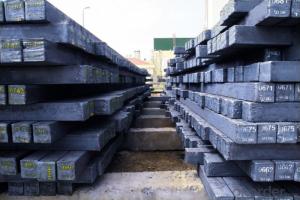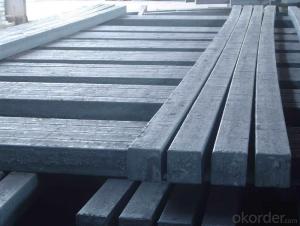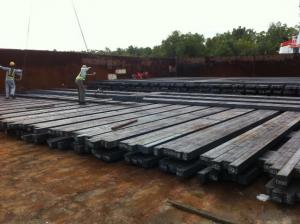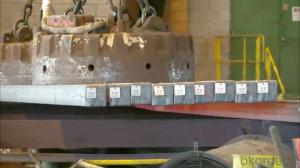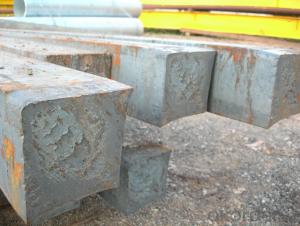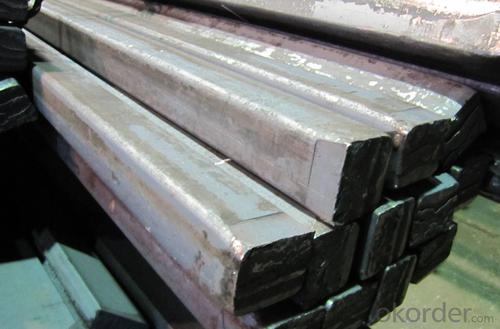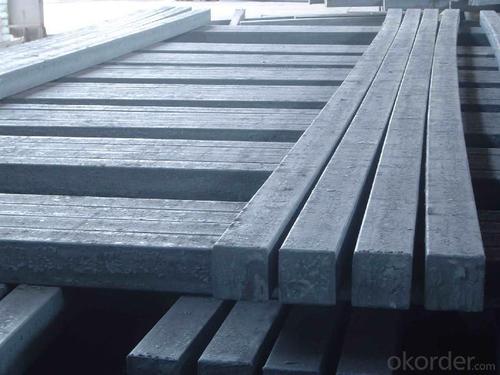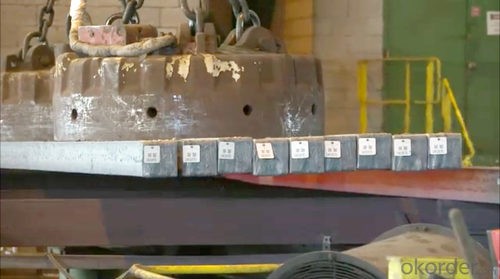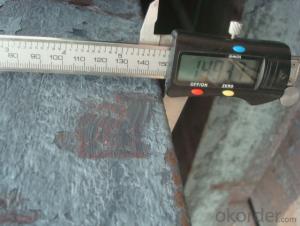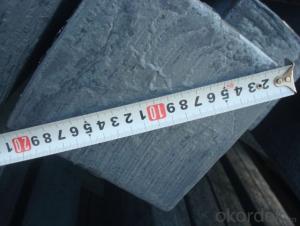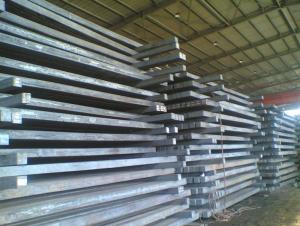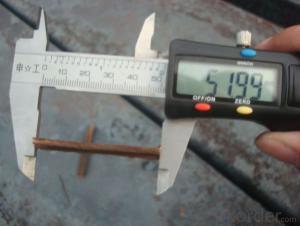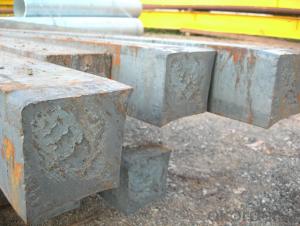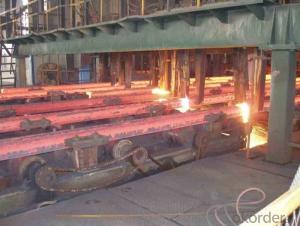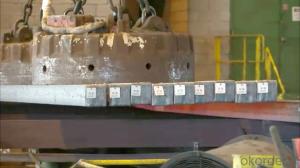Hot Rolled Square Steel Billet 3SP Standard 160mm
- Loading Port:
- Shanghai
- Payment Terms:
- TT OR LC
- Min Order Qty:
- 2000 m.t.
- Supply Capability:
- 10000 m.t./month
OKorder Service Pledge
OKorder Financial Service
You Might Also Like
Structure of Hot Rolled Square Steel Billet 3SP Standard 160mm
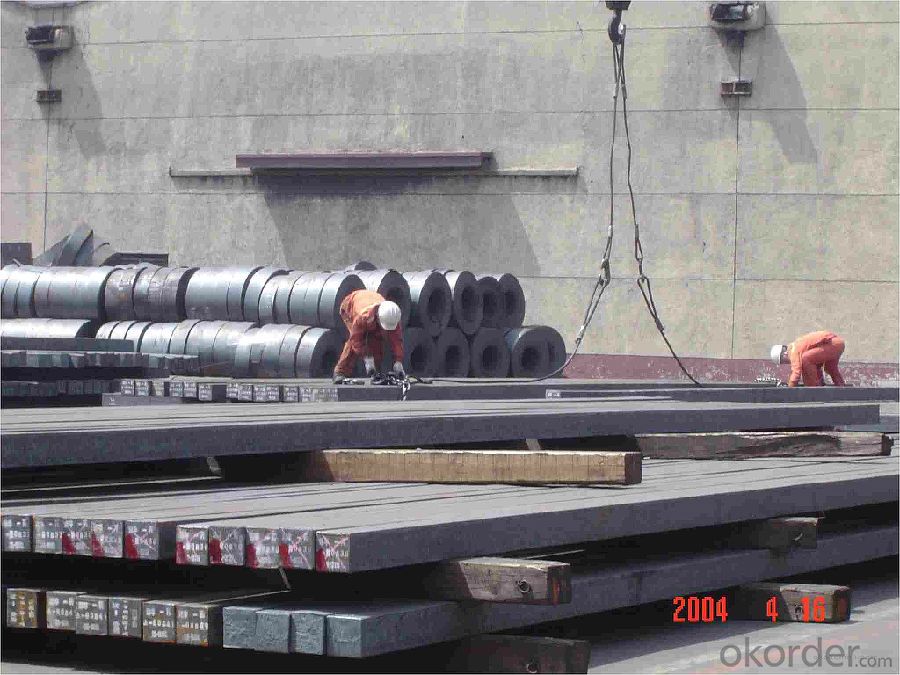
Description of Hot Rolled Square Steel Billet 3SP Standard 160mm
PPGI is made by cold rolled steel sheet and galvanized steel sheets as baseplate, through the surface pretreatment (degreasing, cleaning, chemical conversion processing), coated by the method of continuous coatings (roller coating method),
and after roasting and cooling. Zinc coating: Z60, Z80, Z100, Z120, Z180, Z275, G30, G60, G90
Alu-zinc coating: AZ60, AZ80, AZ100, AZ120, AZ180, G30, G60, G90
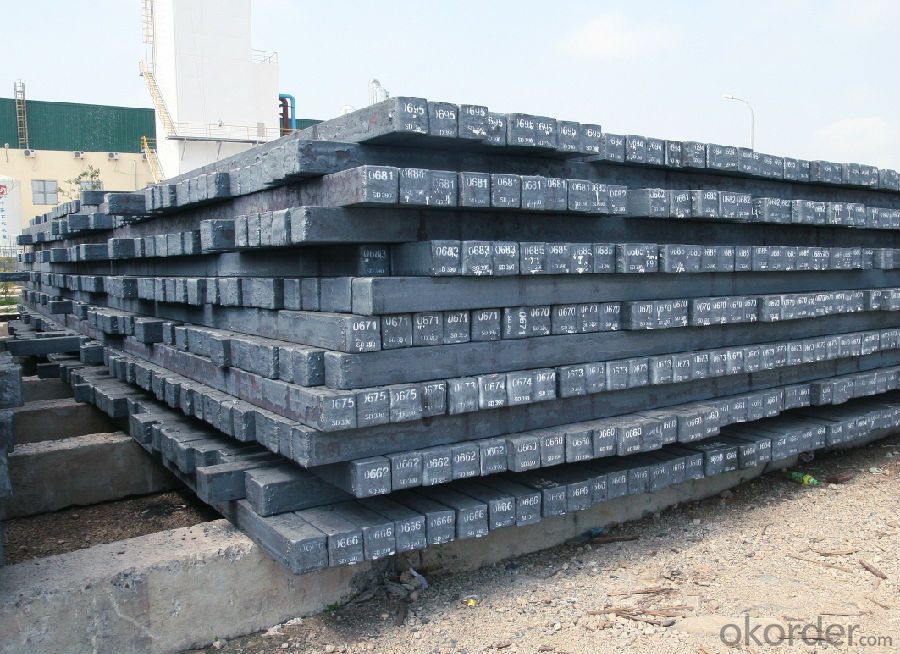
Main Feature of Hot Rolled Square Steel Billet 3SP Standard 160mm
1) Excellent corrosion resistance: The zinc layer provides a good protection of Pre-painted Galvanizeed Steel Sheet.
2) High heat resistance: The reflective surface of the material aids in efficiently reflecting the sunlight away and in turn reducing the amount of heat transmitted. The thermal reflectivity converts into energy savings.
3) Aesthetics: Pre-Painted Galvanized steel sheet is available in plethora of patterns and multiple sizes as per the requirements that given by our customers.
4) Versatility: can be used in the various areas.Standard seaworthy export packing: 3 layers of packing, inside is kraft paper, water plastic film is in the middle and outside GI steel sheet to be covered by steel strips with lock, with inner coil sleeve.
Applications of Hot Rolled Square Steel Billet 3SP Standard 160mm
1) Automotive bodies: filters, fuel tanks, etc.
2) Construction materials: roofings, welding pipes,
3) Electric and electronic appliances: computer cans, etc.
4) Steel cans: containers, etc.
5) Steel furniture: washing machines, refrigerators, microwaves, etc.
6) Drums
7) Office equipment: printer, recorders, etc.
8) Motors and transformers
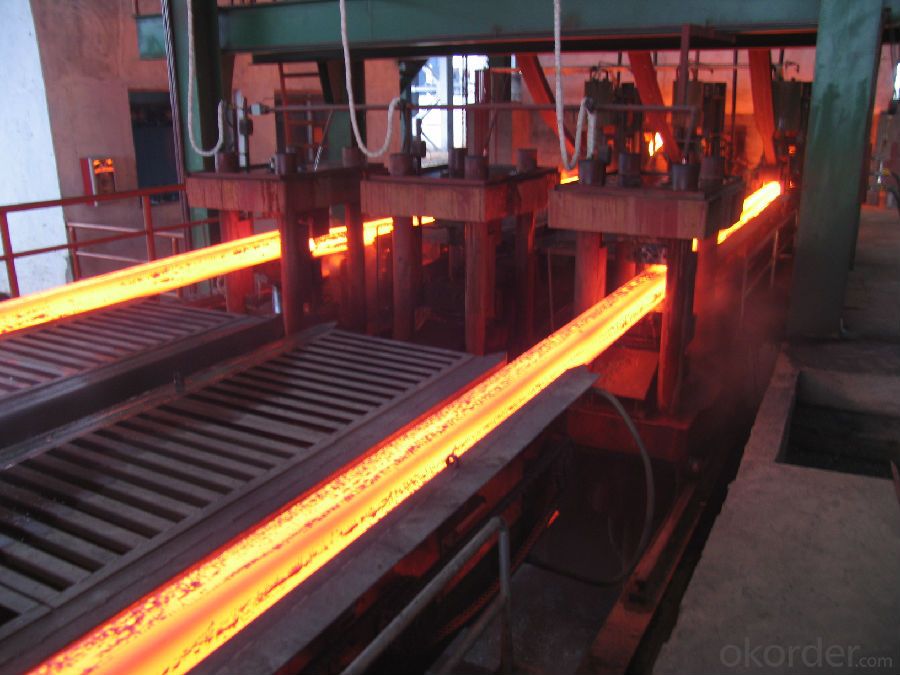
Specifications of Hot Rolled Square Steel Billet 3SP Standard 160mm
| Classified symbol | Yield Point Minimum N/mm2 | Tensile Strength Minimum | Elongation Minimum % | Application | ||||
| N/mm2 | Nominal Thickness mm (t) | |||||||
| JIS | Yogic | 0.25-0.4 | 0.4-0.6 | 0.6-1.0 | 1.0-1.6 | |||
| G3312 | specification | |||||||
| CGCC | CGCC | -205 | -270 | -20 | -21 | -24 | -24 | Commercial |
| CGCD | CGCD | --- | 270 | --- | 27 | 31 | 32 | Drawing |
| --- | CG340 | 245 | 340 | 20 | 20 | 20 | 20 | Structural |
| CGC400 | CG400 | 295 | 400 | 16 | 17 | 18 | 18 | Structural |
| CGC440 | CG440 | 335 | 440 | 14 | 15 | 16 | 18 | Structural |
| CGC490 | CG490 | 365 | 490 | 12 | 13 | 14 | 16 | Structural |
| CGC570 | CG570 | 560 | 570 | --- | --- | --- | --- | Structural |
| ASTM Designation | Yield Point Minimum | Tensile Strength Minimum | Elongation Minimum % | Application | Q/BQB 445-2004(China standard) | ASM A653/A653M | JISG 3312 | |
| ksi(MPa) | ksi(MPa) | TDC51D+Z | (CS TYPE A+Z) | CGCC | ||||
| A653(M)-99 CS TYPE A,B,C | --- | --- | --- | Commercial | TDC52D+Z | CGCD | ||
| A653(M)-99 FS | --- | --- | --- | Lock Forming | TS250GD+Z | (G250+Z) | - | |
| A653(M)-99 DS | --- | --- | --- | Drawing | TS300GS+Z | (G300+Z) | CGC 400 | |
| A653(M)-99 SS Grade33(230) | 33(230) | 45(310) | 20 | Structural | TS350GD+Z | (G350+Z) | CGC490 | |
| A653(M)-99 SS Grade37(255) | 37(255) | 52(360) | 18 | Structural | TS550GD+Z | (G550+Z) | CGC570 | |
| A653(M)-99 SS Grade40(275) | 40(275) | 55(380) | 16 | Structural | ||||
| A653(M)-99 SS Grade50(345) | 50(345) | 65(450) | 12 | Structural | ||||
| A653(M)-99 SS Grade80(550) | 80(550) | 82(570) | --- | Structural | ||||
FAQ of Hot Rolled Square Steel Billet 3SP Standard 160mm
We have organized several common questions for our clients,may help you sincerely:
1. How Can I Visit There?
Our company is located in Tianjin City, China, near Beijing. You can fly to Tianjin Airport Directly. All our clients, from home or aboard, are warmly welcome to visit us!
2. How Can I Get Some Sample?
We are honored to offer you sample.
3. Why choose CNBM?
1, ISO, BV, CE, SGS approved.
2, Competitive price and quality.
3, Efficient service team online for 24 hours.
4, Smooth production ability(50000tons/month) .
5, quick delivery and standard exporting package.
6, Flexible payment with T/T, L/C, Paypal, Kunlun bank, etc.
- Q: How are steel billets labeled for identification purposes?
- Steel billets are typically labeled for identification purposes through various methods such as stamping or tagging, where important information such as size, grade, heat number, and production date are marked directly on the billet or attached to it. This labeling allows for easy traceability and identification throughout the manufacturing and supply chain processes.
- Q: How are steel billets used in the manufacturing of forgings?
- Steel billets are an essential raw material in the manufacturing of forgings. These billets, which are semi-finished steel products, are used as the starting point for shaping and forming various types of forgings. The process begins with the selection of appropriate steel billets based on their chemical composition and mechanical properties. The billets are typically made from high-quality carbon or alloy steel and are carefully inspected to ensure their suitability for the desired end product. Once the billets are selected, they undergo a series of heating and shaping operations. The billets are heated to a specific temperature, known as the forging temperature, in a furnace to make them more malleable. This temperature is carefully controlled to ensure optimal plasticity and minimize any potential defects. After reaching the forging temperature, the billets are transferred to a forging press or hammer. These powerful machines apply immense pressure to shape the billet into the desired form. The force exerted by the press or hammer causes the billet to deform and take on the shape of the die or mold being used. The forged billet may undergo several additional steps, such as trimming, piercing, or machining, to achieve the final desired shape. These steps are necessary to remove any excess material or refine the forged part further. Throughout the manufacturing process, the quality of the steel billets plays a crucial role in determining the final quality of the forgings. The billets must have consistent chemical composition, mechanical properties, and freedom from defects. This ensures that the forged parts have the desired strength, durability, and dimensional accuracy. In summary, steel billets are used in the manufacturing of forgings as the initial material that undergoes heating, shaping, and other processes to create the final forged part. The quality of the billets directly impacts the quality of the forgings, making the selection and inspection of billets a critical step in the overall manufacturing process.
- Q: Can steel billets be used in the production of railway infrastructure?
- Yes, steel billets can be used in the production of railway infrastructure. Steel billets are semi-finished products that are typically used as raw material in the manufacturing of various steel products. In the case of railway infrastructure, steel billets can be further processed and shaped into different components such as rails, sleepers, and fasteners. Rails, the tracks on which trains run, are usually made from steel billets. These billets are heated and passed through a rolling mill to form the desired rail profile. The resulting rail is then further processed to meet specific requirements such as strength, durability, and resistance to wear and fatigue. Similarly, steel billets can also be used in the production of sleepers, which are the supporting structures that hold the rails in place. Sleepers are typically made from prestressed concrete or steel, and steel billets can be used as the raw material for manufacturing steel sleepers. Additionally, steel billets can be used in the production of various fasteners that are essential for railway infrastructure. These include rail clips, bolts, nuts, and washers, which are used to securely fasten rails to sleepers and other components. Overall, steel billets play a crucial role in the production of railway infrastructure. They provide the necessary raw material for manufacturing rails, sleepers, and fasteners, thereby contributing to the construction and maintenance of railway tracks, bridges, and other essential infrastructure elements.
- Q: How are steel billets used in the production of wind turbine components?
- Steel billets serve as a crucial raw material in the production of wind turbine components. These large blocks of semi-finished steel are essential for various manufacturing processes. The fabrication of tower sections is one of the primary uses of steel billets in wind turbine production. The tower is a vital component that supports the entire turbine structure and must withstand strong winds and environmental conditions. To create the tower sections, the steel billets are heated and then rolled or forged into the desired shape and size. The sections are then welded together to form the complete tower structure. In addition to tower sections, steel billets are also utilized in manufacturing other wind turbine components such as the hub, nacelle, and main shaft. The hub holds the rotor blades and the nacelle houses the generator and other critical parts. Both of these components require high-strength steel, which can be obtained through the processing of steel billets. Similarly, the main shaft, which connects the rotor hub to the gearbox, needs to be extremely durable and capable of withstanding the torque generated by the blades. The utilization of steel billets in wind turbine production is driven by the exceptional mechanical properties of the material. Steel provides high strength, enabling the turbine components to withstand the extreme forces they encounter during operation. Additionally, steel possesses excellent fatigue resistance, which is crucial considering the continuous rotation and cyclic loading of wind turbines. In conclusion, steel billets play a vital role in ensuring the structural integrity and reliability of wind turbine components. By incorporating steel billets into the manufacturing process, manufacturers can produce strong and durable components that contribute to the efficient and sustainable generation of wind power.
- Q: What is the role of steel billets in the construction of bridges and tunnels?
- The construction of bridges and tunnels heavily relies on steel billets, which are semi-finished steel products that undergo further processing to create various structural components for the construction industry. For bridges, steel billets are utilized to manufacture steel beams, girders, and columns, forming the core structure of the bridge. These components are essential for providing the required strength and stability to support the bridge's weight and the traffic it carries. Steel billets are chosen due to their high strength-to-weight ratio, making them ideal for constructing long-span and heavy-load bridges. Similarly, in tunnel construction, steel billets are used to create reinforcement bars or rebars. These rebars are embedded within the concrete walls and floors of tunnels, offering additional strength and support to withstand the immense pressure and weight of the surrounding soil or rock. Additionally, steel billets are also employed in fabricating tunnel linings, which protect the tunnel walls from erosion, corrosion, and other forms of deterioration. The utilization of steel billets in bridge and tunnel construction provides several advantages. Firstly, steel is a highly durable and resilient material, capable of withstanding extreme forces, temperature variations, and environmental conditions. This durability ensures the long-lasting nature and structural integrity of bridges and tunnels, reducing maintenance and repair costs over time. Secondly, steel billets can be easily shaped, molded, and welded into various intricate shapes and sizes, allowing for flexibility in design and construction. This versatility enables engineers to create innovative and efficient bridge and tunnel structures, accommodating different architectural and engineering requirements. Lastly, steel billets are renowned for their excellent load-bearing capacity, making them suitable for high-traffic areas such as bridges and tunnels. They can withstand heavy loads and distribute the weight evenly, minimizing the risk of structural failure or collapse. In conclusion, steel billets play a crucial role in the construction of bridges and tunnels by providing the necessary strength, durability, and flexibility. They form the core structure of these constructions, ensuring their stability, longevity, and ability to withstand various environmental and operational challenges.
- Q: What are the main challenges in the recycling of steel billets?
- One of the main challenges in the recycling of steel billets is the presence of impurities and contaminants that need to be removed in order to produce high-quality recycled steel. Another challenge is the need for efficient sorting and separation techniques to properly categorize and process different types of steel billets. Additionally, the energy-intensive nature of the steel recycling process poses a challenge in terms of reducing carbon emissions and achieving sustainability goals.
- Q: How do steel billets contribute to the overall fire resistance of a structure?
- The overall fire resistance of a structure is enhanced by steel billets in several ways. Firstly, steel billets are made of a non-combustible material, meaning they cannot burn or aid in the spread of fire. By incorporating steel billets into a building's construction, the risk of fire propagation is significantly reduced. Secondly, steel possesses a high melting point, typically around 1370 degrees Celsius. This characteristic enables steel to maintain its structural integrity and resist deformation even under intense heat. By using solid steel blocks, known as steel billets, the structure gains strength and stability that can withstand the impact of a fire. Moreover, steel exhibits low thermal conductivity, resulting in poor heat conduction. This property helps to slow down the transfer of heat from the fire to the surrounding areas of the structure. By acting as a barrier, steel billets hinder rapid temperature rise, allowing occupants more time to evacuate and firefighters more time to extinguish the fire. Furthermore, steel billets are frequently utilized in constructing fire-resistant walls or barriers within a structure. These walls are designed to compartmentalize the building, confining the spread of fire and smoke to specific areas. By incorporating steel billets into these fire-resistant walls, the overall construction becomes more durable and capable of enduring the extreme conditions of a fire. In conclusion, steel billets play a crucial role in enhancing the overall fire resistance of a structure due to their non-combustible nature, high melting point, low thermal conductivity, and ability to reinforce fire-resistant walls. By incorporating steel billets into the construction process, buildings can achieve greater resilience against fire incidents, ensuring the safety of occupants and minimizing fire damage.
- Q: Can steel billets be used in the production of mining equipment?
- Yes, steel billets can be used in the production of mining equipment. Steel billets are semi-finished products that are commonly used in the manufacturing industry to produce various types of steel products, including mining equipment. The high strength and durability of steel make it an ideal material for mining equipment, which often operates in harsh and demanding environments. Steel billets can be processed and shaped into different components such as gears, shafts, frames, and buckets, which are essential parts of mining equipment. Additionally, steel billets can be easily welded, machined, and heat-treated to meet the specific requirements and standards of mining equipment. Therefore, steel billets play a crucial role in the production of mining equipment by providing the necessary strength and reliability needed for safe and efficient mining operations.
- Q: Can the production of continuous casting billet be damaged by using intermediate frequency electric furnace?
- If there are no other major facts of harm, it seems that there is no such mandatory legal provisions to bear criminal responsibility. Mandatory closing and fines at most.
- Q: How are steel billets used in the manufacturing of energy sector components?
- Steel billets are used in the manufacturing of energy sector components primarily due to their versatility and strength. These compact, semi-finished steel products serve as the raw material for various energy-related parts, such as turbines, pipes, and power plant equipment. By being shaped and processed through forging, rolling, or extrusion, steel billets are transformed into the required shapes and sizes, ensuring the durability and reliability necessary for the demanding conditions of the energy sector.
Send your message to us
Hot Rolled Square Steel Billet 3SP Standard 160mm
- Loading Port:
- Shanghai
- Payment Terms:
- TT OR LC
- Min Order Qty:
- 2000 m.t.
- Supply Capability:
- 10000 m.t./month
OKorder Service Pledge
OKorder Financial Service
Similar products
Hot products
Hot Searches
Related keywords

